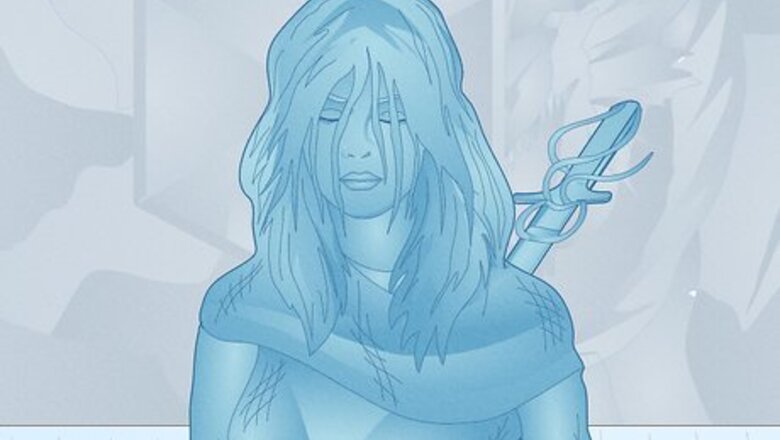
views
- Exhaustion represents the effects of PCs getting pushed beyond their normal limits. There are 6 levels of exhaustion and the effects of each level stack.
- Level 1 imposes disadvantage on ability checks, level 2 halves a creature's movement speed, and level 3 imposes disadvantage on attack rolls and saving throws.
- Level 4 reduces a character's hit point maximum by half, while level 5 reduces their movement speed to 0. Level 6, the final level, causes immediate death.
What is exhaustion in D&D 5e?

Exhaustion is a condition that represents the effects of overexertion. When a player character (PC) gets pushed beyond their normal limits (either by choice or because of a hostile effect in battle), the exhaustion condition is a reflection of being exposed to such tiring circumstances. There are 6 levels of exhaustion that represent how a PC’s weariness can make it more difficult for them to function while adventuring (or in combat). Exhaustion rules can be found in chapter 8 of the Player’s Handbook. The handbook states exhaustion is caused by eating too little, traveling too far, or getting exposed to harsh conditions.
Exhaustion Rules in 5e
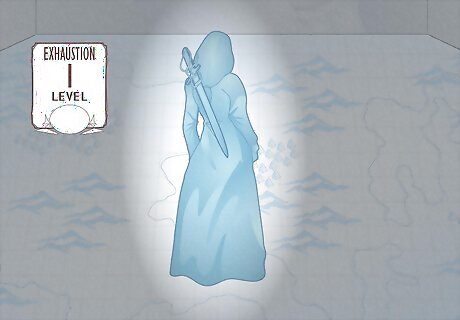
PCs that fail a Constitution saving throw gain a level of exhaustion. When a PC is exposed to one of the causes of exhaustion, they must make a Constitution saving throw. Succeeding the saving throw means the PC isn’t affected by a level of exhaustion while failing the saving throw means they gain a level of exhaustion. Furthermore, levels of exhaustion stack; if a PC is at level 1 and goes to level 2, they feel the effects of both levels. For example: say your PC is traveling and decides to keep pushing through the night rather than making camp (rather than stopping to camp), resulting in 1 level of exhaustion. Then, your PC gets exposed to extreme cold the next day, giving them another level of exhaustion. That means your PC now suffers from both level 1 and level 2 of exhaustion. There are other conditions in D&D 5e, but exhaustion is the only condition with multiple levels of severity that stack based on how many times a PC gets exposed to the condition (and fails their save). Constitution (CON) is an ability score in D&D that measures a PC’s health, vitality, and resilience. That’s why CON saves determine a PC’s ability to resist exhaustion.
Levels of Exhaustion

Level 1 At level 1, exhaustion gives PCs disadvantage on all ability checks. That means whenever your PC rolls an ability check (perception, persuasion, stealth, and so on), they must roll 2d20s (instead of 1) and take the lower of the results. Overall, this makes you less likely to succeed on ability checks—because your character is exhausted. While this level of exhaustion is definitely a hindrance, it’s not a huge problem during combat (since ability checks are rare). Combat mainly involves making attack rolls and saving throws, which aren’t the same as ability checks. Outside of combat, this level of exhaustion can be more of a challenge—but that’s what other party members are for! You can give other PCs the Help action rather than making rolls yourself. Taking the Help action essentially means your PC is assisting another with something, giving them advantage (meaning they can roll 2d20s and take the higher result).

Level 2 At level 2, exhaustion halves a PC’s movement speed. This means your PC moves at half the speed they normally do, making them less mobile in combat. In the long run, it also means your PC can only travel half as far as they usually can over the course of an adventuring day, which can be a significant setback if they need to get somewhere (or leave an area) in a hurry. For example, if your PC is a melee fighter wielding a longsword and shield, half movement will make it more difficult for them to get close to enemies and stop them from going after vulnerable party members.
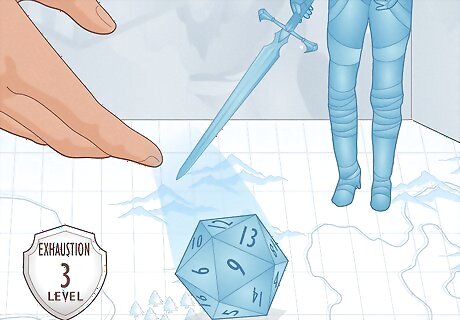
Level 3 At level 3, exhaustion imposes disadvantage on attack rolls and saving throws (in addition to ability checks from level 1 and half-movement from level 2). Altogether, so many debuffs can really affect your PC’s effectiveness on the battlefield regardless of their class (although playing a spellcaster might allow you to avoid making too many attack rolls). Level 3 is also dangerous because it means you’ll roll death saving throws with disadvantage (because it’s a type of saving throw), meaning you’re more likely to fail death saves while exhausted. Death saving throws determine whether your character lives or dies when they’re wounded to the point of unconsciousness.

Level 4 At level 4, exhaustion reduces a PC’s hit point maximum by half. That means your PC’s normal hit point maximum gets cut in half, and they can’t heal beyond the new reduced number. This makes your PC much more vulnerable (and easy to knock out) in battle—which makes the fact that they also roll death saves with disadvantage even more of a potential obstacle.
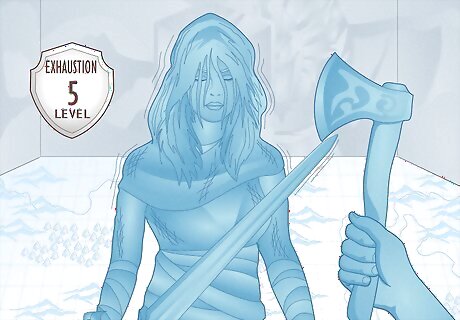
Level 5 At level 5, exhaustion reduces a PC’s movement speed to 0. That means they can’t move at all, in addition to all the debuffs from previous levels. If your PC reaches level 5 of exhaustion, removing at least 1 level (and preferably more) as soon as possible should become your top priority!
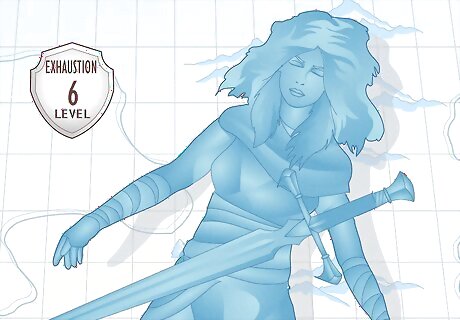
Level 6 At level 6, exhaustion results in a PC’s immediate death—no unconsciousness or death saving throws. Thus, if your PC hits level 6 of exhaustion, there’s no chance of resting or removing any levels to prevent the effects of the condition. However, remember that death doesn’t necessarily mean you can't keep playing D&D with that character; resurrection spells can bring your PC back to life even if they die of exhaustion.
What causes exhaustion in D&D 5e?
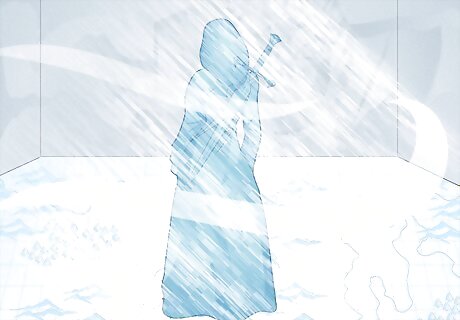
Extreme conditions during travel In D&D, exhaustion is mainly a mechanic designed to affect PCs when they overexert themselves while adventuring. Therefore, most of the conditions that cause exhaustion occur during travel. For example, every hour PCs are exposed to extreme heat or extreme cold (or fall into frigid water), they must succeed on a DC 10 CON saving throw or take a level of exhaustion. Other conditions include: Traveling more than 8 hours per day. If your PC chooses to travel more than 8 hours per day (or travel at a “fast” pace), they take a level of exhaustion. Not eating enough. PCs require 1 gallon of water and 1 pound of food to avoid exhaustion. Your PC can go without food for a few days (3 + their CON modifier), but beyond that, they take 1 level of exhaustion per day. Not drinking water. If your PC drinks less than half the amount of water they need in a day, they’ll need to succeed on a DC 15 CON saving throw or take a level of exhaustion. Swimming or rowing for too long. Swimming for more than 1 hour or rowing a boat for more than 8 hours continuously results in a level of exhaustion. Dashing in combat. Any PC can dash (which means taking extra movement as an action). However, they can only dash a certain number of times (3 + their CON modifier). Dashing more than that results in exhaustion.
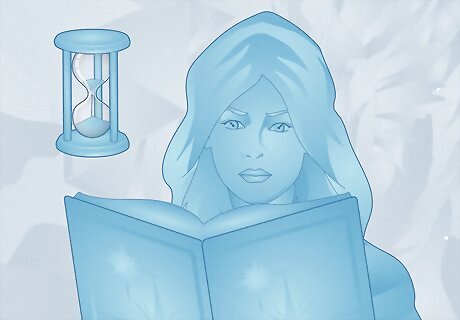
Skipping long rests PCs take long rests to replenish their health and abilities. Long rests are periods of extended downtime that must be at least 8 hours long, with PCs sleeping for the entire time (or doing a light activity like reading or standing watch for no more than 2 hours out of the 8). However, according to Xanathar’s Guide to Everything, PCs that go 24 hours without taking a long rest must make a DC 10 CON saving throw or gain a level of exhaustion. Additionally, the longer PCs stay awake, the more difficult the saving throw becomes. For each additional day your PC doesn’t rest, the DC (difficulty class) increases by 5. However, the DC resets to 10 after finishing a long rest.
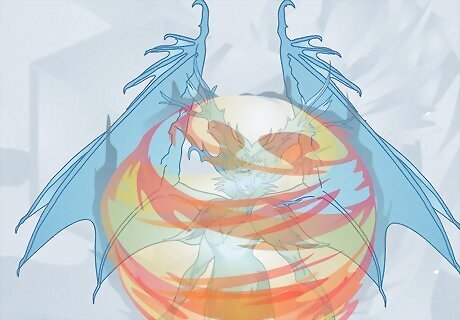
Monsters with exhaustion effects Some monsters or enemy combatants in battle may have access to effects and abilities that inflict levels of exhaustion on PCs. If you’re a DM and want to introduce the risk of gaining exhaustion levels in combat, consider pitting the PCs against such monsters! For example: Soul Mongers (CR 11) have a “Wave of Weariness” ability that inflicts exhaustion. Sibriex (CR 18) are fiends that inflict exhaustion with a “Warp Creature” ability. Kalaraq Quori (CR 19) have a “Mind Seed” feature that causes exhaustion. Gingwatzim (CR 2) are shape-changing creatures with an “Energy Drain” ability.

Spells Sickening Radiance is the only 5e spell you can use to inflict levels of exhaustion on other creatures. It’s a 4th-level evocation spell available to sorcerers, wizards, and warlocks (while also potentially dealing 4d10 points of radiant damage). However, the Tenser’s Transformation spell does cause a level of self-inflicted exhaustion if your PC casts the spell and then fails a saving throw after the spell ends. Additionally, if you’re playing a barbarian character with the Path of the Berserker subclass, going into a frenzied rage results in a level of exhaustion after the frenzy ends.
How to Remove Exhaustion
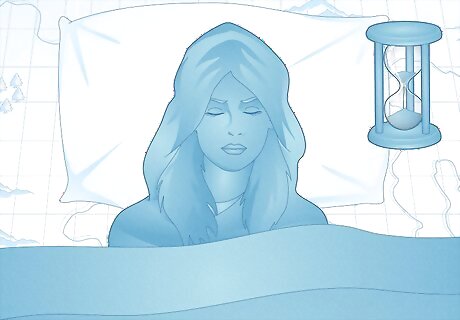
Long rests Taking a long rest is the easiest way to remove a level of exhaustion. For each long rest that your PC takes, they remove a single level of exhaustion (so it may take multiple days to remove multiple levels of exhaustion). However, if your PC sleeps in medium or heavy armor, resting won’t reduce their exhaustion level; light armor (like leather and studded leather) doesn’t impose this restriction. Keep in mind that this only works if your PC also gets the food and water they need as part of the long rest. If they don’t, the long rest won’t remove any exhaustion. Similarly, if your PC is exposed to extreme heat or cold during a long rest, they’ll still need to make saving throws to resist taking additional levels of exhaustion.

Greater Restoration Only 1 spell in D&D 5e can remove levels of exhaustion: Greater Restoration. Greater Restoration is a level 5 abjuration spell available to clerics, bards, druids, and artificers (as well as warlocks with a Celestial patron). Casting Greater Restoration on yourself (or having another character do it) reduces your current exhaustion level by 1. For example, if your PC is at exhaustion level 3 and casts Greater Restoration, their new exhaustion level would be 2. Alternatively, Greater Restoration can be used to remove an effect that has charmed, petrified, or cursed the target, reduced their hit point maximum, or reduced their ability scores. However, remember that the spell only removes a single effect—so if you use it to remove a level of exhaustion, it can’t also end a charm or curse.

Class features If you’re playing a ranger PC, the 10th-level “Deft Explorer” feature allows them to remove 1 level of exhaustion after a short rest (which only takes 1 hour, unlike the 8-hour long rest). If you don’t have this class (or ability), you could use a magic item to remove a level of exhaustion (or simply take a long rest). The Potion of Vitality and the Ring of Temporal Salvation (which are both from The Explorer’s Guide to Wildemount) can remove levels of exhaustion. If you’re a DM, you could also create a homebrew magic item designed to remove a level of exhaustion (or prevent a PC from taking levels of exhaustion).
How to Use Exhaustion as a DM

Incorporate exhaustion into travel to make it more challenging. Often, having your PCs travel over the course of several days (or even longer) can become fairly monotonous. So, why not make them more interesting by having them endure harsh conditions (and possibly take levels of exhaustion)? This can force your players to find creative workarounds and protect themselves from the extreme weather you send their way—whether it’s an ice storm or a heat wave. You could also heighten the intrigue by planning an ambush after a day of traveling where your PCs were exposed to extreme conditions. For example, you could have a group of bandits try to sneak up on camping PCs that just traveled through a blizzard. Some of the PCs could have a couple of exhaustion, making the battle more challenging for them!

Raise the stakes of a battle with effects that can exhaust PCs. Any of the monsters mentioned above (from Sibriex to Soul Mongers) can inflict levels of exhaustion in battle—which can rapidly weaken PCs if they take multiple levels of exhaustion over consecutive turns. Alternatively, stage a battle with any monster in a location with extreme conditions or lair effects that can give PCs levels of exhaustion, making it imperative for them to win the battle as soon as possible. This could be especially impactful if you create a villain who likes to wear their victims down slowly, creating a sense of oncoming doom and making players feel the suspense! If you decide to plan a battle and incorporate the exhaustion condition, make sure it’s still a balanced encounter. Give your PCs a challenge, but don’t force them into an impossible situation. Try using an encounter builder (like the one available on D&D Beyond) if you want to make sure your battle is well-balanced.
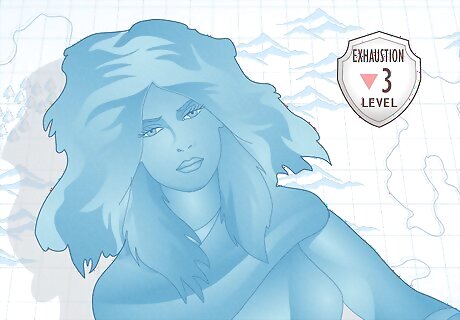
Consider using exhaustion when PCs wake up after being unconscious. Normally, falling unconscious and then waking up again (either due to healing or eventually stabilizing) doesn’t impose levels of exhaustion. However, some DMs choose to implement a homebrew rule (meaning it’s their rule, not from the official 5e rulebook), stating that PCs who get knocked out and then revived take a level of exhaustion as a result of losing consciousness. PCs fall unconscious when their hit point total drops to 0. While unconscious, they can’t do anything but make death saving throws. However, healing spells can bring unconscious characters back to consciousness. If you’re DMing for a party with plenty of healing capabilities, they might not be too worried about falling unconscious in battle. Thus, a homebrew rule that adds levels of exhaustion after being unconscious creates more stakes for the PCs, encouraging them to think more strategically to avoid getting knocked out.

Implement exhaustion in creative ways. If you can think of a situation in real life that leaves you feeling physically or mentally exhausted, try including it in your gameplay. Anything from a supply shortage to high levels of stress could logically leave a PC feeling fatigued, so don’t be afraid to ask your PCs for CON saving throws against exhaustion—even if the cause isn’t listed in the 5e rulebook. You’re the DM, so it’s ultimately your call. For example, if one player says their PC is very stressed over something, consider having them roll a saving throw against exhaustion each day until the stress lessens. Alternatively, if one PC enters a drinking contest and wins, consider giving them a point of exhaustion the next day from drinking all that ale!

Make it clear when PCs might make a decision that leads to exhaustion. In D&D 5e, PCs can gain exhaustion by overextending themselves and trying to travel further than their bodies would normally allow for the day. If your PCs are in a hurry, they might choose to do this anyway—but make sure they know what they’re signing up for. Verbally clarify that they can stop and rest (and potentially lose time) or keep going (but risk weakening themselves with exhaustion). If your players don’t fully understand the consequences of pushing forward and overextending themselves while traveling, they might be upset when their PCs start getting exhausted. It’s best to give your players a clear understanding of the situation so they can make informed decisions!












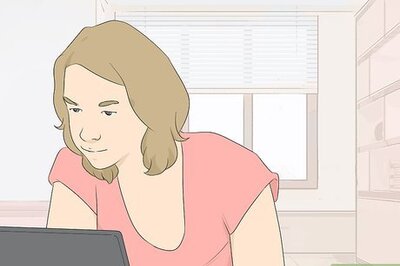
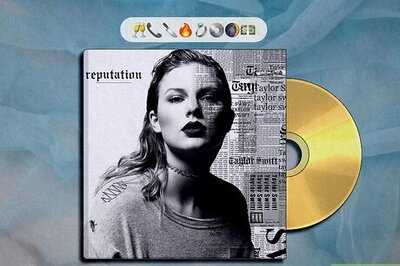

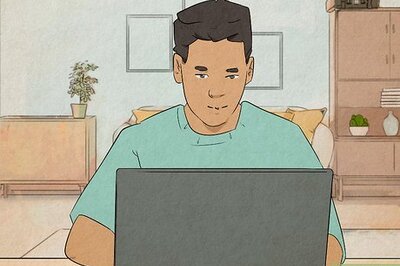
Comments
0 comment